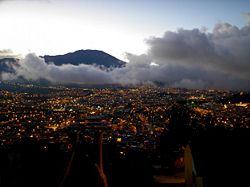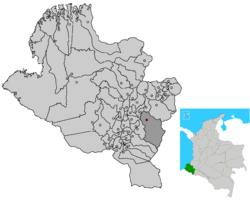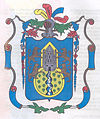Pasto
| Pasto | |||
| — City — | |||
| San Juan de Pasto | |||
 |
|||
|
|||
| Nickname(s): Ciudad Sorpresa (Surprise City) Ciudad Teológica (Theological City) Tierra del Galeras (Galeras's Land) |
|||
| Motto: "Muy Noble Y Muy Leal Ciudad de San Juan de Pasto" ("Very Noble and Very Loyal City of San Juan de Pasto) "Viva Pasto, Carajo!" (Go Pasto, Damnit!) |
|||
 |
|||
| Coordinates: | |||
| Country | |||
|---|---|---|---|
| Department | Nariño | ||
| Founding | 1537 | ||
| Established | 1539-06-24 (Atriz Valley) | ||
| Founder | Sebastián de Belalcázar | ||
| Named for | Saint John the Baptist | ||
| Government | |||
| - Type | Municipality | ||
| - Mayor | Eduardo Alvarado Santander | ||
| Area | |||
| - Land | 1.181 km² (0.5 sq mi) | ||
| - Urban | 26.4 km² (10.2 sq mi) | ||
| Elevation | 2.527 m (8.290 ft) | ||
| Population | |||
| - City | 399,723 hab. | ||
| - Density | 365/km² (945.3/sq mi) | ||
| Time zone | (UTC-6) (UTC) | ||
| Postal code | 90-210 | ||
| Area code(s) | 092, 072, 052 | ||
| Website: www.pasto.gov.co | |||
Pasto, officially San Juan de Pasto, is the capital of the department of Nariño, located in southwest Colombia. The city is located in the "Atriz Valley", on the Andes cordillera, at the foot of the Galeras volcano, at an altitude of 8.290 feets (2.527 m) above sea level. The city has a population of approximately 450,000 inhabitants.
Contents |
Economy
Pasto is the centre of an agricultural region specializing in the production of dairy products. The manufacturing of furniture is an important part of the local economy. The city is an important centre of commerce and trade with nearby Ecuador.
Carnival and arts
One of the most important events held by the city is the Blacks and Whites' Carnival (Carnaval de Negros y Blancos in Spanish), with outstanding displays of craftmanship in floats portraying legends and traditions, often mixed in with references to current political events in Colombia. During the carnival the city goes wild and unleashes all the joy it has bottled up all year. It is not advisable to wear your best clothes during this festival as during these celebrations people have fun painting each other's faces with cosmetics colors (skin safe and created for this special purpose) and throwing talcum powder and party foam. The carnival takes place from the 2th to the 6th of January each year.
A speciality of this region is a pre-Columbian art technique called Barniz de Pasto, or Pasto Varnish in English. This uses a type of natural rubber (extracted from a tree called mopa-mopa) which is colored and then stretched over woodwork pieces; finally the skillful artisan uses a special knife to cut and create the many beautiful designs that characterise this artistic technique.
History
Pasto was originally founded in 1537 by the Spanish conquistador Sebastián de Belalcázar, in 1539 the also Spanish conquistador Lorenzo de Aldana move the city to its actual location, and established there under the name "San Juan de Pasto". Pasto is a reference to the name of the indigenous people who inhabited the region at the arrival of the conquerors, the Pastos, however the Atriz Valley was inhabited by the Quillacingas.
It has been an administrative, cultural and religious center of the region since colonial times, because of this, the city is known as the theological city of Colombia. During the Independence Wars against Spain Pasto was a royalist city unlike the rest of the country, so after gaining independence and because of its geographical location, it remained for long time isolated from the rest of the country which has resulted in the traditionalist attitude and cultural self-absorption of its people.
On June 25, 2006 Deportivo Pasto became the champion of the 1st division of soccer in Colombia.


Education
- University of Nariño
External links
Pasto travel guide from Wikitravel
- San Juan de Pasto:Fotos, chat, carnavales, rumba, chicas, amigos, tropicana
- Photos of the "Carnaval de Blancos y Negros"
- Culture of The Pastos
- Pasto through the picture
- San Juan de Pasto
- Universidad de Nariño
- Universidad Mariana
- Photos Carnaval de Negros Y Blancos Pasto
- Mayor's office
- Ciudad Sorpresa
- Deportivo Pasto
- Attake Massivo
- Pasto Volcanological and Seismological Observatory - INGEOMINAS
- Sobre el barniz de Pasto
- Pasto Weather
- Pasto, General
|
|||||||

